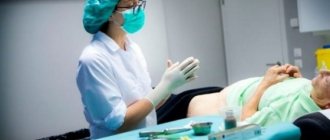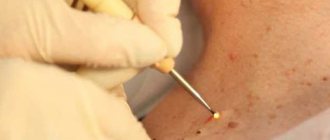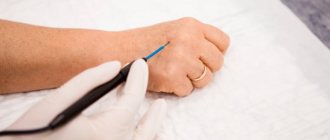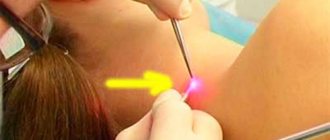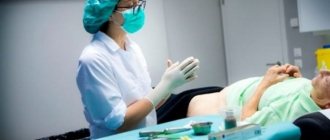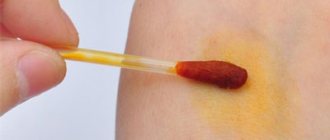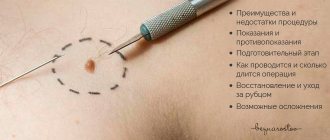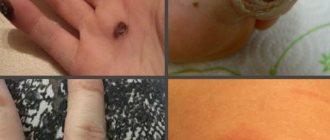Condylomas are classified as sexually transmitted diseases. They can also be transmitted through breastfeeding - from mother to child and during childbirth.
The main cause of these growths is considered to be the human papillomavirus. There are many strains of the virus. All of them carry a very high oncogenic potential. Most often, infection and propagation of the infection occurs when a person’s immunity is weakened (illness, stress).
The patient feels discomfort at the site of condyloma, itching, and increased humidity in intimate places.
What consequences can condylomas lead to if they are not removed?
Condyloma is by no means a harmless neoplasm. The virus causes changes in cells that resemble those that occur in malignant tumors. Currently, the connection between human papillomavirus infection and cancer can be considered proven.
Genital warts often cause a host of other problems: they can become injured and bleed, ulcerate, and interfere with sexual intercourse and childbirth. In general, if growths in the form of warts are found in intimate places, it is better to immediately consult a doctor and have them removed.
Causes of perianal condylomas
The disease is caused by human papillomavirus (HPV) types 6 and 11.
HPV infection occurs in most cases through sexual contact. During anal sex, infection directly in the anus area is possible. During normal sexual intercourse, the genitals are first affected. It should be borne in mind that the virus can remain in a “dormant” state for a long time, becoming more active when immunity decreases or during stress.
Advantages of radio wave surgery using the Surgitron device
Doctors at the ProfMedLab clinic remove genital warts using the modern Surgitron radio wave surgery device. The principle of the method is that the device generates high frequency radio waves. Coming into contact with tissues, they evaporate liquid from cells, that is, they actually destroy them. Radio wave surgery has some advantages:
- Purposeful action. Only affected tissues are destroyed, while surrounding healthy tissues remain untouched. In this regard, radio wave surgery is a more gentle method compared to laser.
- Good cosmetic effect. After removal of tumors using the Surgitron apparatus, barely noticeable scars remain.
- Full control over the process. The surgeon can precisely control the area and depth of tissue removed.
- Bloodless intervention. There is no bleeding during genital wart removal.
- Fast recovery. The wound heals completely within a few days. There is virtually no pain or swelling.
Why Surgitron and not laser or cryodestruction?
Radiosurgery really has advantages over all modern methods of condyloma removal:
- Laser and liquid nitrogen are used only in relation to small formations, while for radio waves the size does not matter;
- Less heating and minimal tissue damage give an almost painless effect, which is not always possible with other techniques;
- Incorrect laser settings can lead to various complications; Surgitron is much easier to operate and safer;
- Electrocoagulation works in much the same way, but it produces scars, unlike radiosurgery.
Attention! The price for removing 1 formation using radio waves ranges from 2 to 4 thousand rubles in different clinics. In government agencies, this procedure is performed free of charge if equipment is available.
Removing condylomas with liquid nitrogen
If a laser destroys condyloma by heating, then liquid nitrogen does this using low temperature. In the language of doctors, this is called cryosurgery. Compared to laser and radio wave surgery, it has a number of disadvantages:
- Usually a bubble remains at the intervention site, then it is opened, after which it takes about 2 more weeks to heal.
- It is more difficult to control the area of influence. Cold damages healthy tissue 1–2 cm around the condyloma.
- For 1–2 days after surgery, you experience quite severe pain.
Main indications
The most common indications for tumor removal:
- rapid increase in the size of condylomas;
- a sharp increase in their number;
- large size of condyloma and lack of response to drug treatment;
- location of formations in places exposed to a high risk of injury;
- constant inconvenience in everyday life (during urination, sexual intercourse);
- risk of complications during the upcoming birth (location on the cervix);
- aesthetic and psychological discomfort due to the visible location.
Contraindications include:
- pregnancy;
- oncological diseases;
- colds;
- herpes in the area of the neoplasm;
- skin damage;
- diabetes.
Is it possible to remove condylomas with celandine?
Celandine juice contains substances that can destroy tissues affected by the papilloma virus. In principle, this traditional method of treatment works, but it is low in effectiveness (it will take several days to remove the wart) and is useless for large, numerous condylomas. Modern medicine offers more effective treatment methods, one of them is radio wave surgery.
What happens after removal of condylomas using radio waves?
A small wound remains at the site of the intervention. As a rule, it heals completely within 5–7 days, and new pink skin appears in its place.
How to properly care for the wound after surgery?
After removing condyloma using radio wave surgery, potassium permanganate and other aggressive agents should not be used, and the wound should not be allowed to dry out and form a crust on it: the best cosmetic effect is achieved with moist healing.
What can and should be done:
- In the first days, carefully monitor the condition of the wound.
- Treat it with warm soapy water.
- Take a bath and shower.
- Drink enough fluids.
- Consult a doctor immediately if pain begins to bother you, lumps appear, or skin color changes.
What not to do:
- Tear off the crust if it still appears. This can cause a noticeable scar to form.
- Apply cosmetics to the wound.
- Visit swimming pools, baths and saunas until the wound has healed completely.
- Keep the wound in the sun and visit solariums.
- Press on the wound, injure it.
You will receive more detailed recommendations from your doctor at the clinic. Feel free to ask questions.
Is additional treatment necessary after genital wart removal?
Genital warts are a viral disease, so removing them alone is not enough. If the virus remains in the body, it can cause a relapse. The risks increase if you have a weakened immune system, have chronic diseases, or if you often change sexual partners. In order to cope with the pathogen, the doctor will prescribe antiviral drugs and agents that strengthen the immune system.
Is it possible to remove condylomas during pregnancy?
Pregnancy and breastfeeding are contraindications to the use of radio wave surgery. It is better to get rid of genital warts at the planning stage. Other contraindications to the use of the Surgitron device: severe diseases of the heart, lungs and other organs, acute infections, the presence of a pacemaker, exacerbations of chronic diseases, epilepsy, cancer, infectious and inflammatory processes on the skin. If a woman is having her period, she will have to wait until it ends.
To find out if there are any contraindications in your case, visit a doctor at the ProfMedLab clinic.
How can one reliably diagnose human papillomavirus infection in genital warts?
Genital condyloma is easily recognized during an external examination by any dermatovenerologist. The doctor may order additional tests:
- A Papanicolaou smear (PAP test) helps detect abnormal cells.
- PCR detects the genetic material of the pathogen in smears and scrapings.
- The Digene test helps detect high cancer risk viruses and assess the risk of a malignant tumor.
Removal of genital warts using radio waves using the Surgitron device is a quick, low-traumatic and painless procedure. You can take it at the ProfMedLab clinic. To make an appointment with a doctor, call: +7 (495) 308-39-92.
How to prepare for the procedure
During the consultation, the doctor collects a complete history of the patient’s life and illness. To achieve the desired result, the most effective removal method is selected. The doctor prescribes a preliminary examination, which includes:
- clinical analysis of blood, urine;
- extended colposcopy;
- oncology research;
- fluorographic examination of the chest organs;
- testing for viral hepatitis, HIV;
- blood test for Wasserman reaction;
- performing an immunogram.
The medical staff should tell the patient about the procedure and possible complications. A few days before, you need to stop taking medications that affect blood clotting. Immediately before the procedure, the patient needs to calm down and relax.
Removal of condylomas with laser during pregnancy
Pregnancy is considered a contraindication for the removal of any tumors on a woman’s body. This also applies to condylomas, despite the discomfort they cause. In most situations, the doctor prefers to choose a wait-and-see approach and observe the pregnant patient until childbirth, in order to take all necessary measures in the postpartum period to remove the condylomas that have developed in the woman. This happens if the virus that caused the tumors does not belong to the oncogenic types and, in fact, does not pose a serious danger.
If condyloma cells contain viruses of types 16 and 18, this means that they can degenerate into cancerous tissue. Before this happens, the tumors should be removed with a laser or other means. In such a situation, the operation is performed in the third trimester.
Attention!
This article is posted for informational purposes only and under no circumstances constitutes scientific material or medical advice and should not serve as a substitute for an in-person consultation with a professional physician.
For diagnostics, diagnosis and treatment, contact qualified doctors! Number of reads: 320 Date of publication: 09/06/2018
Dermatologists - search service and appointment with dermatologists in Moscow
What is radiocoagulation?
Radiocoagulation is the removal of genital warts using special equipment - Surgitron. The principle of operation of this device is to convert electric current into heat rays, which are collected at the top of the electrode (radio knife). It acts as a guide element and its size is selected depending on the diameter of the build-up. Under the influence of thermal energy, condyloma cells dry out and burn out.
Radio wave destruction is one of a number of gentle procedures that effectively eliminate growths up to 5 mm without affecting healthy tissue. During the operation, the patient does not feel discomfort, and the small wound remaining after removal of the condyloma heals in a matter of days.
How warts are removed using radio waves can be seen in the video at the end of the article.
Diagnosis of the disease
Before removing genital warts, specialists at the Miracle Doctor clinic conduct not only an external examination, but also laboratory tests, which make it possible to make an accurate diagnosis and exclude concomitant diseases (herpes, STDs, etc.).
Laboratory tests/ This is the basis for diagnosing HPV, since external manifestations of condylomatosis (condylomas lata) may indicate other pathologies (for example, secondary signs of syphilis).
- Swab from the vagina or penis for PCR. The analysis reveals the presence of DNA sections of the virus, strains and quantity.
- Tests for syphilis and HIV. They are performed to exclude pathologies in the patient and make a correct diagnosis.
- Tests for STDs. Condylomatosis often develops against the background of sexually transmitted infections; the treatment program is developed taking into account their presence.
- Immunogram. The analysis allows us to determine the state of the immune system and the stage of development of condylomatosis.
- Oncocytology. A smear from the surface of condylomas is taken from both men and women to exclude malignancy of the neoplasm.
Biopsy of the tumor. It is carried out if precancerous conditions and oncological tumors provoked by the HPV virus are suspected. The doctor takes a section of modified tissue for histological examination in the laboratory for analysis.
Colposcopy. The procedure is carried out when condylomas are detected in women during a gynecological examination and involves a detailed examination of the walls of the vagina and cervix using a special microscope. A targeted biopsy is also performed under the control of a colposcope.
Urocystoscopy. The examination is carried out if there are condylomas in the urethra. An endoscope, which is a thin flexible tube with optics and a light at the end, is inserted into the urethra and allows you not only to examine its walls, but also to perform a biopsy.
Drug treatment
At the moment, there are no medications that can completely eliminate the virus from the body. HPV infection is characterized by a recurrent course, so signs of the disease can reappear at any time. In this case, spontaneous spread of warts to other skin areas often occurs. The doctor can prescribe only symptomatic therapy to the patient to alleviate the course of the disease.
Possible destinations
- Topical products containing immunomodulatory drugs. Applying cream or ointment to the affected area helps prevent further growth of condylomas.
- Podophyllotoxin is a chemical compound that has a cytostatic effect. Using this product in the form of an ointment or gel helps eliminate warts.
- Products based on trichloroacetic acid for cauterization of condylomas.
These medications can cause side effects such as skin redness, allergies and bleeding. Only the attending physician can prescribe topical medications after a thorough examination of the patient.
Prognosis and prevention
In most cases, the prognosis is favorable. Unless the patient is immunocompromised, HPV infection rarely causes symptoms. It is important to undergo regular examinations to exclude the growth of skin tumors. Stable immunity to pathology is not developed, so re-infection is always possible.
Ways to prevent and prevent the development of complications:
- using condoms;
- treatment of other sexually transmitted diseases;
- compliance with personal hygiene rules;
- undergoing an examination by a venereologist once a year;
- elimination of factors that adversely affect immunity. It is necessary to give up alcohol, smoking and take enough vitamins.
Vaccination against oncogenic strains of HPV is prescribed for girls and young women. The greatest effectiveness of such prevention is achieved if immunization is carried out before the first sexual contact.
Thus, genital warts are signs of the presence of human papillomavirus in the body. The disease is easily detected using laboratory tests, but treatment is limited to symptomatic therapy and elimination of complications of the disease.
Reasons for the development of the disease
- active sex life, frequent change of partners;
- refusal to use contraceptives;
- using someone else's towels, washcloths or other hygiene products;
- chronic diseases (tuberculosis, HIV, diabetes);
- hypovitaminosis, weakened immunity, etc.
In addition, the cause of condylomatosis (overgrowth of genital warts) can be regular overwork. Bad habits, stressful situations, and hormonal imbalances also contribute to weakening the immune system. The risk of infection from a partner with genital warts is more than 80%. The incubation period lasts from 1 to 8 months.


